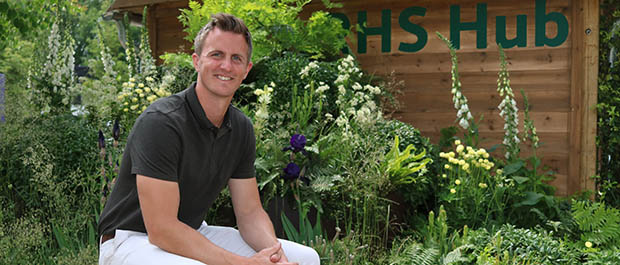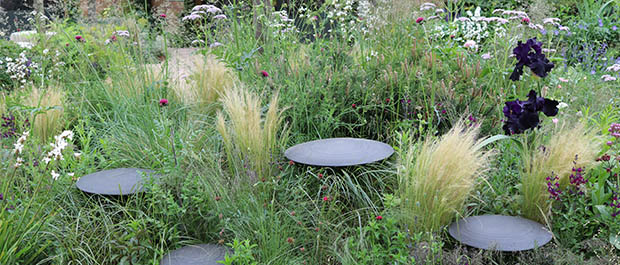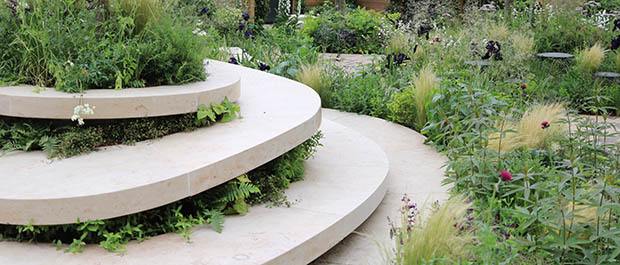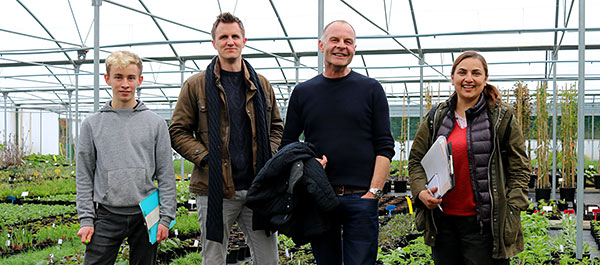
“It’s inspired by the work we’re doing for the health and wellbeing garden we’re doing for Wisley. I want it to be an immersive space. No matter how busy and chaotic Main Avenue can be I want people to look at our garden and feel drawn towards it and feel at complete ease as they move throughout the space and the way we’ll achieve that is by having no straight lines or forced paths – there’s seemingly no direction – you don’t go from A to B, there’s no sculpture at the end of an avenue. It’s more organic in its form and the way I’ve set out the paths. It’s a way to make people feel like they can move through the space at their own pace, in their own time without any real agenda – just to go and get lost really.
Interaction
“In terms of how this garden could potentially help improve heath and wellbeing, I think most the of gardens at Chelsea will be beautiful, but that’s the point, if you can create a garden that’s beautiful to look at you can break a thought process and if that’s what it takes to just forget the everyday stresses or anxiety that you might feel then that’s what we’re looking to do – give people benches or options and places to rest, sit and quietly contemplate and give them focus on the space and it’s hopefully going to be a garden that works for people not just looking at it from the outside but also moving through it. That’s the lovely thing this year, I’ve got the chance for the first time to invite people through the garden because it’s the RHS Garden. It makes a nice change. It’s the one thing that’s been missing with the other three gardens I’ve done – you get to the end and your focus is on what it looks like from the outside and it’s just such a shame that people don’t get the chance to experience it.
“This one needs to be an interactive space. The planting is going to be tactile, there’s going to be a sculpture in there that we’re going to encourage people to interact with and feel the different textures and enjoy the garden in that way. It’s is really exciting for me to be able to do this one.
Works for everyone
“There’s also a series of terraces that’s a play on what we’re doing at Wisley – giving people a different vantage points, so even if you’re not moving through the garden you can stand up on this terrace, look almost over the top planting and feel like you’re within the garden and that’s something we’ve been working on with the Wisley team and the science department, working on how we can help people with different disabilities – dementia patients for example need a sense of enclosure to make them feel secure and we’ll do that with planting so when you’re sitting on a bench you’ll feel completely enveloped by the planting. You’ll have that sense of security without losing focus of the wider landscape. It’s quite a difficult balancing act – you need to make someone feel secure without closing off the entire perimeter from floor to ceiling and we’ll do that through layered planting. It should make for a really lovely effect whether you are suffering or just want to walk through a really lovely space.
Legacy
“The garden will live on again. It’s being done in association with the NHS mental health trust. They had 38 applicants for the garden and that accounts for three quarters of the mental health trusts in the UK. They’ve all applied because they need some decent outdoor space and wherever it ends up it will make a huge impact and a dramatic difference. The great thing is that as well as it working as a space to move through and help patients recover, you can also get to appreciate the garden from an aerial perspective from the upper floors. That’s going to help just as much. If you’re looking out to the grounds as they are – boring concrete – to enable them to have nice looking trees to look at the canopies or just a well structured space will entice people through it and as results have shown it will speed up recovery. We’ve been working with the Wisley students and the NHS to try and come up with something that is going to help the patients who are going to use it.
“That’s what was lovely about the Help for Heroes Garden (2014) – it’s one thing exhibiting at Chelsea and putting on a bit of a show but if there’s a legacy to it and if it can help at the same time it’s great.
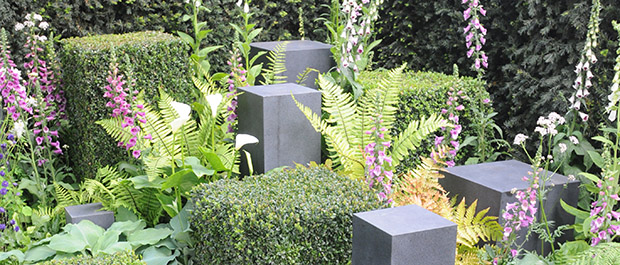
“If you can make people feel at ease and feel comfortable in their surroundings, immediately it reduces stress and reduces heart rate and therefore blood pressure and anxiety levels.
“It’s going to be manic on Main Avenue but if someone has two minutes to sit down and focus on a planting combination or a sculpture, or just looks up at the trees and that breaks the everyday thought processes and relives stress and anxiety then we’ve done our job.”
After the show, Camden and Islington NHS Foundation Trust (C&I) will receive the garden. C&I provides inpatient and community mental health services and the garden will be located at its Highgate Mental Health Centre, one of its two inpatient psychiatric sites.
Photos from the 2018 Chelsea Flower Show:
